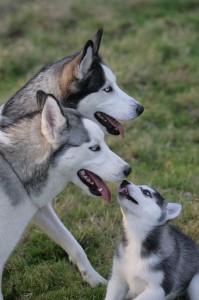If we want to understand our dogs’ emotions, we have to see dogs for what they are and not what we wish they were.
A Cocker Spaniel sniffed around and seemed disinterested in working with her handler. “She’s just sulking because I didn’t take her to the park today,” recalls an exasperated handler. In moments like this, I have to wonder whether the dog really feels this or if it’s just the handler projecting his or her own human guilt onto the dog.
Without the facility of language between humans and dogs, we are left to make a lot of assumptions about what’s going on in the minds of our dogs. Do dogs sulk? Do they get jealous? Do they have hopes and dreams?
We have enough scientific and anecdotal evidence these days so it’s not likely anyone would deny that our dogs do have emotions. But this is where the discussion gets fuzzy, even contentious. When we begin to try to pin down and relate to those emotions, opinions differ — and here we find the broadest of all possible spectrums, from those who choose not to spend money on anesthetic for medical procedures for their dogs (they don’t believe dogs feel “pain”) to those who attribute remarkably human emotions such as altruism and empathy to their dogs.
The sciences of animal biology, psychology, and animal learning theory are providing us with some interesting new insights. While the biology of a brain is remarkably consistent across all mammals, each successive new species layers its own new variations and additions up to largest brains in humans, dolphins, and whales.
But where does the “emotion” come from? Is it in the more primal areas of the brain structure common to all mammals or is it found in higher areas of the brain that are specialized to different species? Apparently the answer is not as simple as finding where emotions come from in the brain.
Biology and the Brain
The latest research seems to suggest that emotions, at a bio-chemical level, originate in the more primitive areas of the brain. Dr. Jaak Panksepp of Washington State University’s College of Veterinary Medicine, has been one of the foremost researchers on emotions and the brain. His book, Affective Neuroscience: The Foundations of Human and Animal Emotions, remains one of the most important scientific works on the subject.
In his book, Dr. Panksepp describes what he terms “Blue Ribbon Emotions”, seven core emotions that he believes are common to all mammals. Panksepp identifies these core emotions because they generate well-defined behavioural responses when specific centers of the brain in different species are stimulated. Panksepp identifies SEEKING, RAGE, FEAR, PANIC, LUST, CARE, and PLAY as these core emotions.
But knowing where in the brain emotions come from is not the same as understanding what causes them. This is where biology can cloud the issue. If we take a larger view of the differences in the biology of dogs and humans, the contrasts are stark. While dogs and humans share the same senses of taste, touch, smell, hearing, and vision, the mechanisms by which we experience our world through those senses differs significantly.
Our eyesight is much more acute and accurate for determining visual detail than that of dogs while their eyesight is much more attuned to sensing and detecting motion in a much wider visual field (approx. 270 degrees compared to the average 180 degree human field).
A dog’s hearing is more sensitive than ours in that they can detect greater variation in volume, but their directional sense for locating a sound is not as good as ours. A dog’s sense of smell is estimated to be 100,000 times more acute than a humans. And this says nothing of the differences in the taste and touch mechanism that differ so much between species. Same senses, but a very different experiences.
Expression and Experience
In his work with animals and behaviour, noted psychologist B.F. Skinner referred to the animal mind as a “black box” — the thought processes and motivations of animals related to the behaviours they exhibited. He called it a black box because we can never know what the actual thoughts and motivations of our dogs are with any certainty. All we have to go on is the outward expression of their emotions. But these outward expressions don’t tell us much about what it feels like to the dog.
I have seen my dog Tiramisu finish a particularly good agility run with me and she seems to be smiling a big fat satisfied smile on her adorable face. I love that look. But what I cannot know is if she feels “satisfaction” in the same way that I do. I can’t even know that she feels the emotion of “satisfaction” specifically. I can tell from her outward behaviour that she’s happy.
Science tells us that dogs do, in fact, have emotions and our own experiences with our dogs confirms that. Where things get murky is whether or not we can recognize them and respond to them appropriately. In her book, For the Love of a Dog, ethologist and animal behaviourist Patricia McConnel describes watching trainers working with their dogs and praising them enthusiastically while the dogs cringed and pulled back. The owners were apparently oblivious to the emotional expressions of their own dogs. How can this be?
The Trap of Projection
One of the great disadvantages our dogs have in their lives with us is that they can’t correct us when we misunderstand their emotions. Humans are very visually oriented and we communicate primarily vocally through use of complex language. Dogs, on the other hand, take in the world (so far as we can tell) primarily through their nose and communicate via a series of movements, body postures, facial expressions, and vocalizations that are not language in the way humans understand it.
But there is enough similarity between dogs and humans, and enough familiarity with them, that we humans frequently try to map our experience and emotions onto our dogs. Our dog will frequently look at us in a certain way or make a sound or movement we think we recognize from our human experience. Our immediate response is to associate his gesture with its human counterpart.
One example of this is when a dog lowers its head and averts its gaze. When my dog performs this gesture, she will glance up at me furtively to see what my response will be. The human analogue for this gesture would be “guilt”, i.e. she looks like she’s done something wrong and is “ashamed” of herself. In fact, in the body language of dogs, this is called an “appeasement gesture” designed to turn off stressful or uncomfortable situations. My dog is not, in fact, feeling “guilty”, she just wants to fix what ever is bothering me and making things uncomfortable between us. Perhaps she just fears that I’m about to do something unpleasant like leave her alone in the house for a while.
In her book The Other End of the Leash, Patricia McConnell details dozens of examples of how humans and dogs may see the same situation very differently. It’s a fascinating book and I encourage you to read it. Many times in those pages, I found myself making the common mistakes McConnell describes so well.
Instead of having a handle on my dogs, I found I was in fact projecting my own emotions onto them. How unfair of me! It took me a fair bit of reading and re-training of myself to let go of my own perceptions and to try to put myself into my dog’s place and try to see the situation from its viewpoint. Heck, that’s hard enough to do with members of my own species!
The Power of Observing
The good news is that reading our dogs’ emotions can be done. The better news is that our dogs are a remarkably forgiving sort; they have lots of patience for us. We live in a time where both science and dog trainers around the world have been gathering lots of good information on the behaviours dogs exhibit and how these correlate to various emotional states.
There are lots of great books and DVDs now available to help dog owners understand the biology and behavioural expression of different emotions in their dogs.
Turid Rugaas, a dog trainer in Norway, has been studying dogs and their “calming signals” and has published a number of books on dogs and how they communicate. Brenda Aloff, a dog trainer in the US, has devoted a lot of effort to studying and analyzing canine behaviour. Veterinarian Bonnie Beaver has also produced an excellent book about dogs and their behaviour from a clinical standpoint. The work of these dedicated people and others in both the dog training and scientific fields are helping us gain new insights into the inner lives of our dogs.
But if we truly want to understand our dogs for what they are, we have to take off the “rose colored glasses” of conventional wisdom about dogs. The persistence of myths such as “pack hierarchy” and “dominance theory” are examples of how we seem to prefer comfortable, time worn, and totally incorrect explanations for many of our dogs’ behaviours. If we want to understand our dogs’ emotions, we have to see them for what they are and not what we wish they were.
Is there some common emotional ground between us and our dogs? Of course there is — the work of neuro-scientists like Jaak Panksepp shows this clearly. But we are, after all, different species with very different experiences of the world. Just like our relationships with our friends and family members, a little understanding can go a long way.
I would encourage every dog owner to do a little observation and learn what their own dogs do when they are happy, sad, lonely, frightened, or excited. Checking out a few websites, books, or DVDs never hurts either.
I’ll leave you with this one thought I took away from Jean Donaldson’s book Culture Clash the first time I read it: How much better is it that we should love dogs for who they truly are rather than being occasionally disappointed by their failure to be human like us.
Photo Credits
Waiting – Ed Yourdon 2010 from Flickr
Happiness – Muffet 2006 from Flickr
Focused – Goingslo 2010 from Flickr
Dogs – Pixel Spit 2006 from Flickr






My dogs shower me with adoration and attention. They seem to enjoy the activities that we do together and appear to prefer to be with me rather than off doing something on their own. How easy it is to assume that they are oddly shaped little people, with the same feelings and motives that I have. It should be clear that they are not people, and yet, how easy it is to forget that they are not. While I don’t agree with the Cocker Spaniel handler, I think I understand why she believes as she does.
Another thoughtful article, E. I think it’s so easy to treat our four-legged friends as “small humans” but they clearly are not. I hope every dog (or any species) is better for our enriched understanding of how they think and feel.
Thanks for helping us to live better lives with our animal companions!